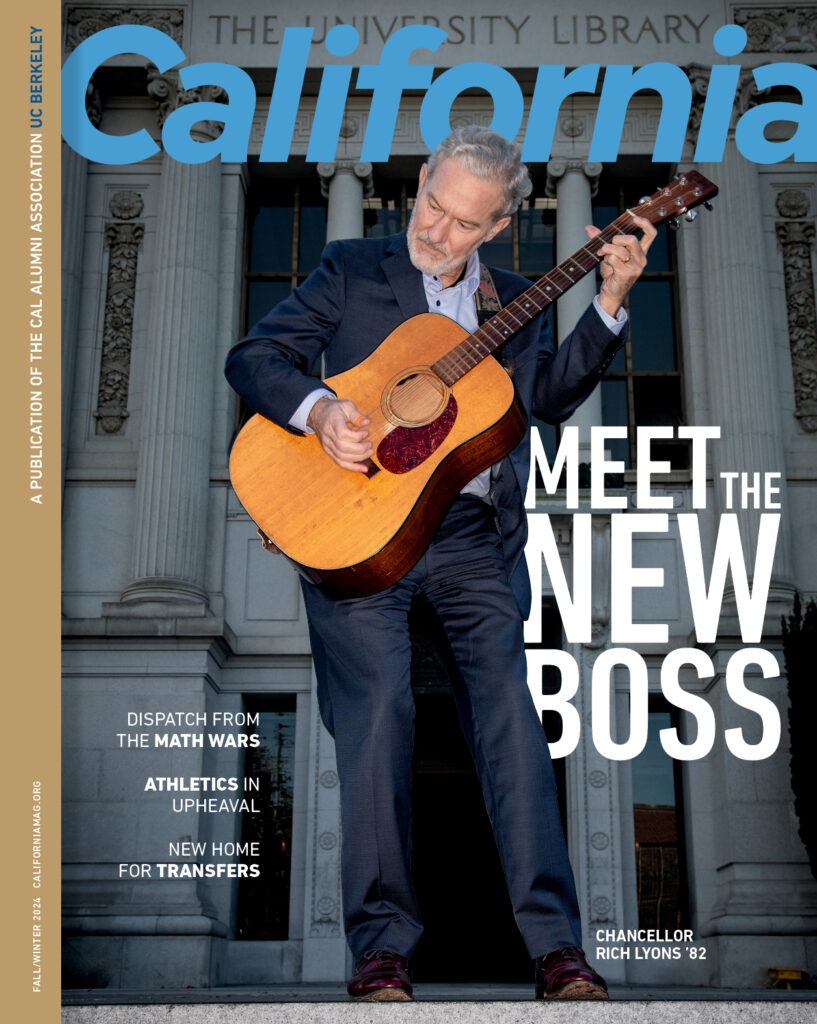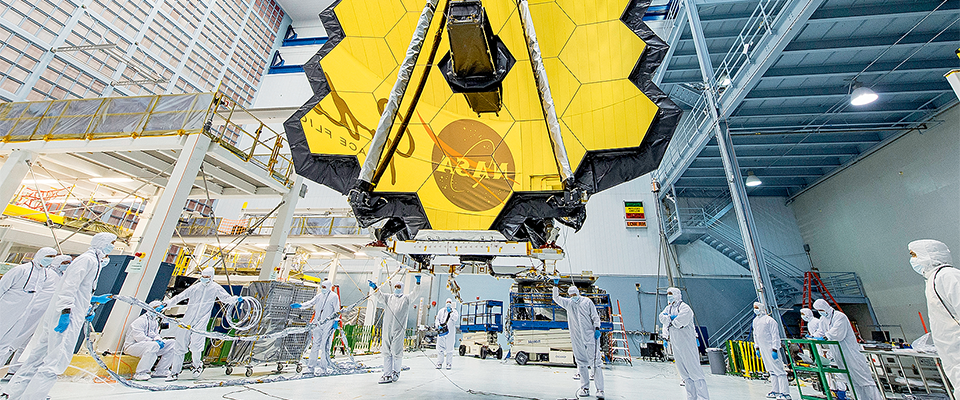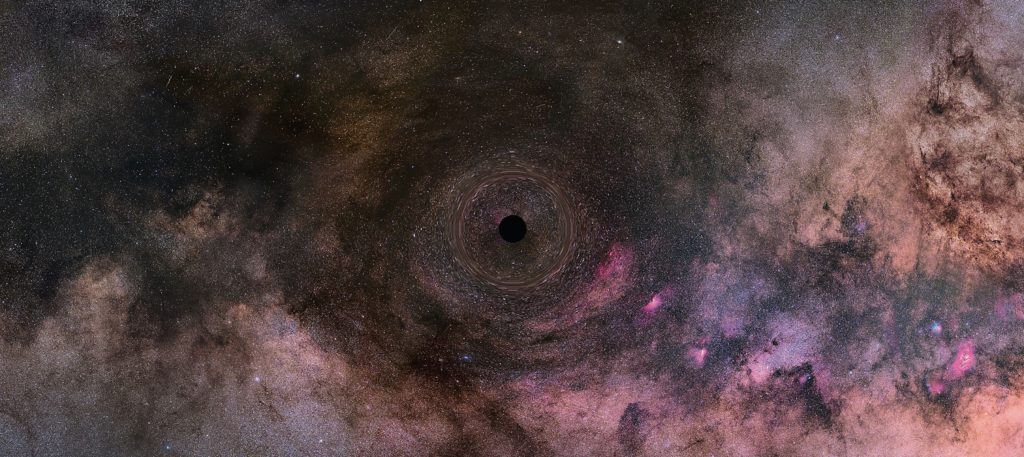Two months before NASA unveiled the first images from the James Webb Space Telescope to the world last summer, some 50 astronomers and engineers anxiously gathered in the mission control room at the Space Telescope Science Institute in Baltimore for the moment of truth. Finally, after a 35-year-long, seemingly insurmountable journey through technological adversity, threatened cancellations, and a pandemic, the newly calibrated $10 billion observatory was about to reveal how well it worked—or didn’t.
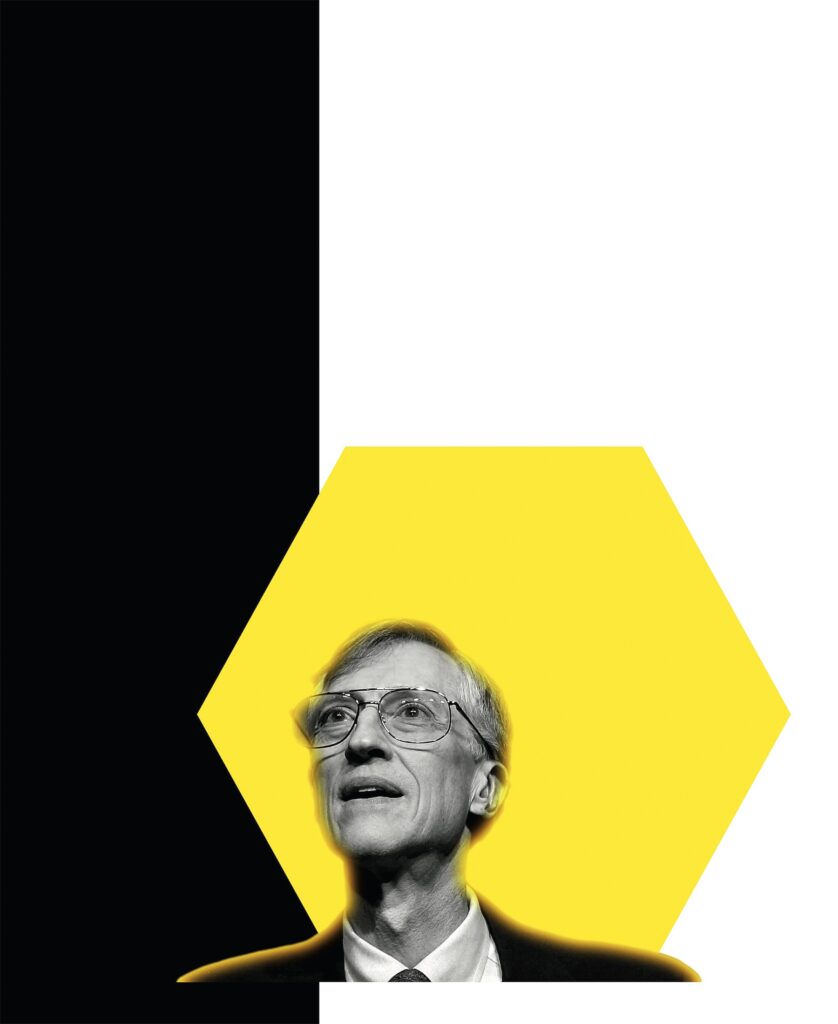
Among those awaiting that first test shot was John Mather, the mission’s senior project scientist, Nobel laureate, and senior astrophysicist at NASA’s Goddard Space Flight Center. The team had focused the observatory’s massive 21-foot hexagonal mirror on a single star surrounded by utter blackness. But when countless lights suddenly peppered the image, there were audible gasps. “My God, there were just galaxies everywhere!” Mather says. “It was such a wonderful surprise and relief.” Then they broke out the champagne and a bottle of Cognac from 1906, the year James Webb was born.
It was an emotional moment for the normally unflappable scientist, who’d spent nearly three decades helping to shape and champion the mission’s science objectives—some requiring technology that had yet to be invented. The most sophisticated astronomical instrument in history is designed to capture infrared light from 13.6 billion years ago, enabling views of the early universe some 200 million years after the Big Bang. The data it collects over the next decade will give us a new understanding of how galaxies, stars, and planets formed in the early cosmos, whether planets orbiting nearby stars (exoplanets) might support life, and the makeup of our solar system.
“This is all part of one thing, which is ‘How did we get here?‘ We’re living our own history by looking at the rest of the universe.“
John Mather
“This is all part of one thing, which is ‘How did we get here?’” says Mather, now 76. “The Big Bang happens; galaxies, stars, and planets grow; they all get enriched with chemical elements. And so here we are. Where did everything here come from? We’re living our own history by looking at the rest of the universe.”
The JWST was arguably the most inspiring science story of 2022. Its launch the previous Christmas and the flawless unfolding of its sun shield and primary mirror en route to an orbit 1 million miles away were remarkable feats of engineering. The breathtaking images that followed revealed stunning insights into the nature of the cosmos. For Mather, it was yet another summit in a storied half-century career in infrared astronomy and cosmology that included the 2006 Nobel Prize in Physics (with Berkeley Professor Emeritus George Smoot) for capturing data supporting the Big Bang model. He has also advised NASA’s Science Mission Directorate, the National Academy of Sciences, and the National Science Foundation; earned five dozen awards; engaged in some three dozen scientific papers; and coauthored the book The Very First Light.
“Every day, I worked with engineers to say, ‘OK, this is what we want to do. How can we do it together?’”
John Mather
For these achievements, the UC Berkeley Foundation and the Cal Alumni Association have granted Mather, Ph.D. ’74, the UC Berkeley Alumnus of the Year Award for extraordinary advances to the betterment of society, which was presented at the Berkeley Charter Gala on May 11. “He’s inspired not only numerous Berkeley faculty and students, but even the most amateur astronomers and citizens worldwide,” says Achievement Awards Cochairman Ahmad Anderson ’83. “His contribution makes us think about life and existence and what we can do to sustain that on Earth.”
Since 1995, Mather has led the JWST science team from the observatory’s gestation through its harvest of vibrant images. He’s helped to choose its members, decide which objectives to pursue and how to achieve them. “Every day, I worked with engineers to say, ‘OK, this is what we want to do. How can we do it together?’” he says.
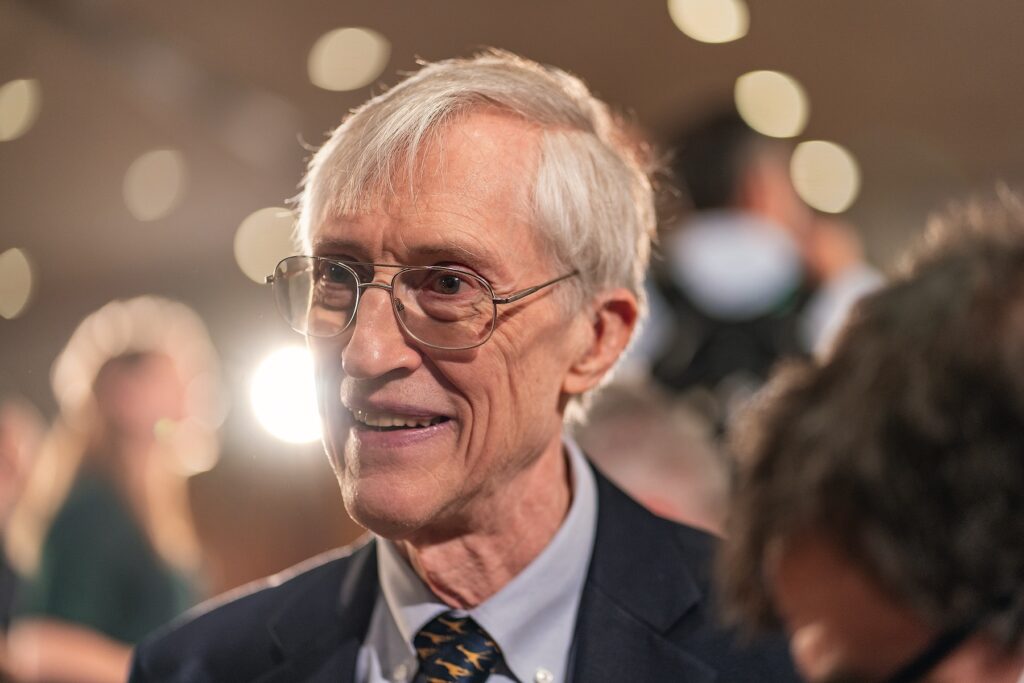
“He really trusted his team to perform,” says Mike McElwain, a JWST observatory project scientist who has worked under Mather since 2013. “He let us take responsibility, and not all leaders do that. But it forced us to work harder. He isn’t afraid to take on really challenging projects. If physics doesn’t rule something out, then he knows it can be done.”
Mather is a lanky 6’ 4” presence who radiates calm brilliance—a big mind who drops folksy phrases like “my golly,” tackles Herculean obstacles with optimistic persistence, and doesn’t worry about issues beyond his control. “Most of the time I’m a pretty cool character,” he says. “My having an opinion about it doesn’t make any difference to the hardware.”
As illustration, take his Zen reaction to the JWST launch. Once in space, the craft emerged from the rocket fuselage, unfurling like a butterfly from a cocoon as it embarked upon 50 major deployments with 178 release mechanisms. Engineers practiced the incredibly involved process for more than a half-dozen years with the real telescope in a vacuum, in cavernous dust-free clean rooms, and via computer simulations. Now the moment had come. If anything went wrong, the space telescope would be space junk. While the launch and deployment had most folks holding their breath, Mather’s take was, “It’s all working according to plan.”
Such Jedi traits guided him from a rural New Jersey childhood through a rarified career. “He’s obviously very smart, but he’s also confident, good-natured, and down-to-earth,” says Michael Werner, a close friend since their Berkeley days who went on to become project scientist for the Spitzer Space Telescope. “He doesn’t put on airs or pretend he did it all himself. He’s grateful for the opportunities he’s been given and supportive of the people he’s worked with over the years. He’s really a model of a scientific statesperson—very generous with his time, and gracious and helpful to younger scientists.”
GOING FOR SOMETHING COOL
Mather grew up on an experimental farm run by Rutgers University, where his father was an agricultural science statistics professor. As a child, he delighted in all types of science. He was often fascinated by the danger it presented when countering beliefs of the day, like 17th century astronomer Galileo Galilei enraging the Catholic Church by insisting the Earth orbited the sun. Despite an early aptitude and indulging in summer physics and math programs, it wasn’t until he won a statewide high school physics contest that he realized he might be something special. “That was my decision point,” he says. “I thought, ‘You really could go for something cool.’”
Not that other distractions wouldn’t occasionally pull his focus. After graduating from Swarthmore College in 1968, he took a summer job at Lawrence Berkeley National Laboratory with plans to attend graduate school at Princeton University, which had yet to go coed. “But my friends there—all guys—said, ‘If you’re not married, don’t come; there are no women here,’” says Mather. He stayed at Berkeley and informed Princeton why. “The next year, Princeton accepted women.”
Despite that perk, Berkeley in 1968 proved a massive culture shock when the nerdy country kid from a small bucolic college found himself in a city awash in protests, police violence, and the looming threat of the Vietnam War.
“My draft number came up, but I failed the physical because I was extremely nearsighted, which was OK with me. I didn’t want to go,” he says. “It felt like our country was under attack from the inside—the people who did not want to go to Vietnam and fight versus the people who thought if you didn’t go, you were a traitor. It was hot feelings at the time.”
The tumult was such that it almost lured him from physics when he thought he might be a more effective activist as an attorney—only to recoil at the law school class catalog. “I realized, ‘Oh, I don’t want to know any of this! I better stick to what I like already.’”
Outside of his studies, Mather found refuge with a Big Bang Theory–like group of housemates that included a couple of physics students, an aspiring psychologist, a writer, a former nuclear reactor piping engineer, a high school buddy who’d left the Air Force, and a drooly Great Dane named Khan. “He could reach a pound of butter in the middle of the dining table without getting onto it,” says Mather. They roomed together in their affectionately dubbed “Walnut House,” an old brown-shingle home on Walnut Street that now exists only in memories.
By 1970, he’d yet to refine his direction in physics. Faced with choosing a thesis project, Mather joined a research group led by Paul Richards, Ph.D. ’60, now a Berkeley professor of physics emeritus. They, along with Werner, then a postdoc, were devising projects to measure cosmic microwave background radiation (CMBR), the cooled remains of the first light from the Big Bang that had been discovered a few years earlier. Mather and Werner built a far-infrared spectrometer in a successful attempt to measure the spectrum of CMBR from the White Mountain Research Center’s Barcroft Station in Eastern California.
“We had a lot of fun together doing experiments,” says Werner, who remembers Mather’s curiosity was such that once, just for kicks, he crafted a method to measure seismic activity from underground atomic tests then taking place in Alaska.
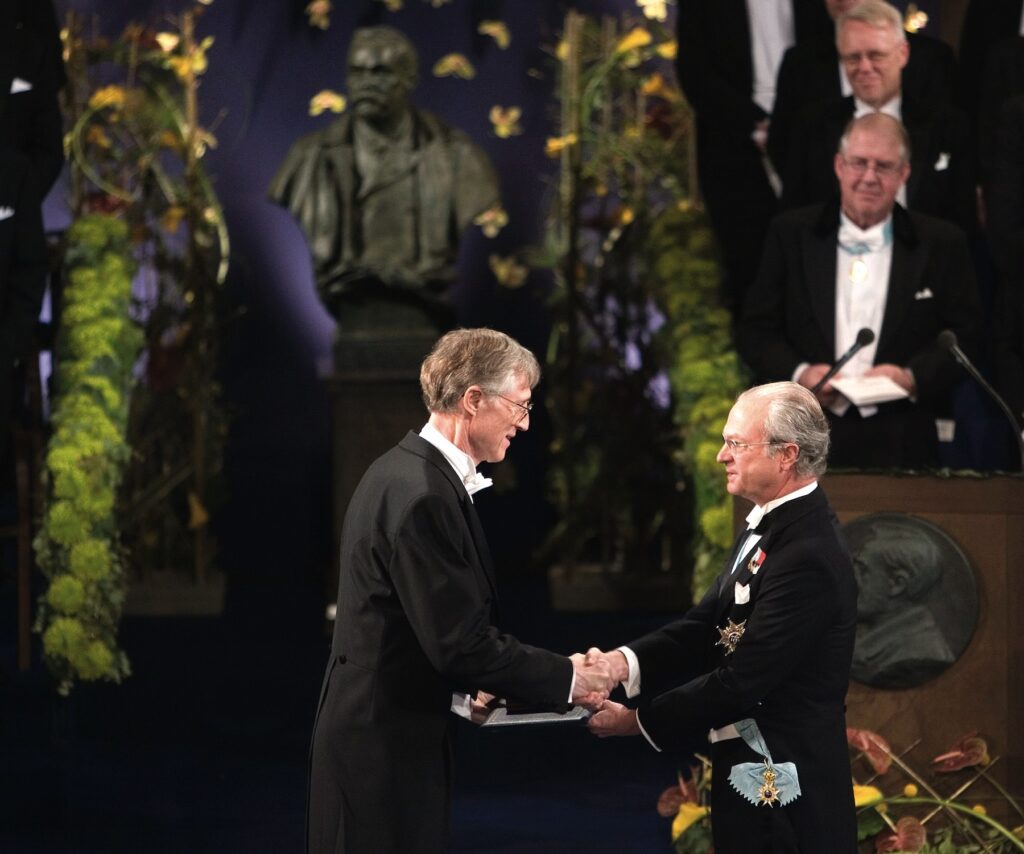
The following year, Mather and Richards teamed with another lab member, a Ph.D. student named David Woody, now a radio astronomer and assistant director of Caltech’s Owens Valley Radio Observatory. Woody and Mather shared a cosmology class taught by the late Charles Townes, then a Berkeley professor who shared the 1964 Nobel Prize in Physics for his work in quantum electronics. Woody ’68, Ph.D. ’75, remembers Mather being so bright that whenever he volunteered an answer, “I had to figure out why it was right.”
They built a microwave spectrometer to measure CMBR from a high-altitude balloon they launched in Palestine, Texas, that could gather data above the atmospheric water vapor that would absorb their signal. The pair drove down in a U-Haul truck carrying their equipment, and Woody laughs at the memory of the towering Mather, then an inch taller than he is now, struggling with average-size motel beds on the way. “He had to put a suitcase at the foot of the bed so he could rest his feet.”
Not only did their work inform Mather’s thesis, but building instruments for remote and hostile locations grounded his next steps. Graduating in 1974, Mather continued this research as a National Research Council postdoctoral fellow at the Goddard Institute for Space Studies in New York. There, he led the proposal for the Cosmic Background Explorer (COBE), a satellite designed to take more precise CMBR measurements.
It was during this time that he met Jane Hauser, a classical ballet teacher he encountered in a personal growth workshop, who would become his wife of 42 years before passing away last November. Hauser brought an artistic flair to Mather’s world, often coaching and encouraging him in writing and speaking. The pair shared a life of travel, learning, collaborating, and “daily hugs.”
“She loved her work and wanted a man who loved his work, so he would understand hers,” he says. “Everything I am, everything I do, everything I own has her mark.”
When NASA greenlit a more formal study of COBE two years later, Mather moved to Goddard Space Flight Center in Greenbelt, Maryland. There he became COBE project scientist and the principal investigator for one of its instruments, the Far Infrared Absolute Spectrophotometer (FIRAS), leading a team of more than 1,000 scientists and engineers. The satellite, launched in 1989, provided the compelling evidence of the Big Bang theory that eventually earned Mather and Smoot their Nobel.
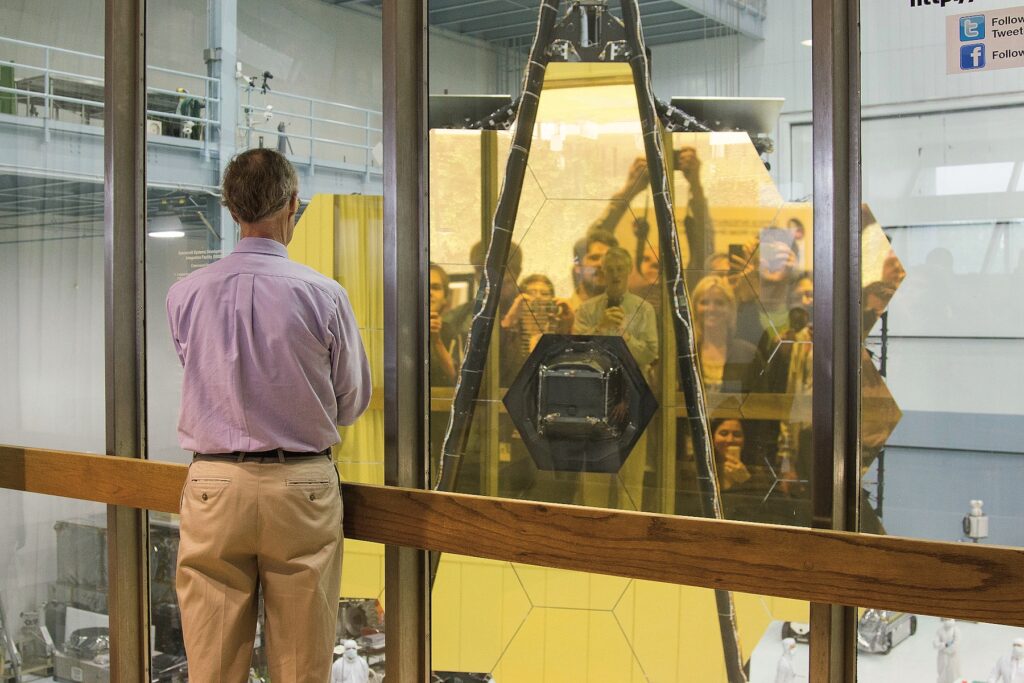
Their measurements of radiation from the early universe revealed a spectrum—similar in form to the glow of an incandescent bulb, but at wavelengths invisible to our eyes—that matched predictions of what light from the Big Bang would look like now. Their measurements further showed that the radiation wasn’t equally bright in all directions, but instead varied with infinitesimally warmer and cooler spots. These resulted from density variations in dark matter and gas, the other components of the universe. Without those density variations, gravity could not have pulled together the primordial material into galaxies, stars, and planets. “We wouldn’t be here without those spots,” says Mather. The Nobel Foundation heralded their findings as “the starting point for cosmology as a precision science.”
Mather remained with the COBE mission until it ended in 1993 and joined the JWST mission—then called Next Generation Space Telescope—two years later as it was ramping up to peer beyond the view of the Hubble Space Telescope. (Its official name, honoring James Webb—NASA’s administrator from 1961 to 1968—came in 2002.) It would be a turbulent journey. NASA woefully underestimated the costs, time, and technology to make it viable, initially allotting just $500 million to develop the telescope for an anticipated 2007 launch. When ensuing cost overruns and construction delays threatened to shut it down in 2011 and 2019, Mather helped rally staff by keeping a steady eye on the prize.
“I just had faith it would all work out. And even if it didn’t, I wasn’t going to give up.”
John Mather
“His composure was just what was needed when the crap hit the fan,” says astrophysicist Garth Illingworth, the last of the telescope’s three original architects still involved in the mission. (The trio began brainstorming the telescope in 1986.) “He remained a strong, positive voice for the science, and a reminder of why we were building it and the broad questions it would answer.”
To Mather, there was simply no other option. “There was no competition for this observatory, no other way you could get this information,” he says. “I just had faith it would all work out. And even if it didn’t, I wasn’t going to give up.”
The study of the cosmos is a continuum. COBE and its successor satellites, along with the great space telescopes like Spitzer and Hubble, helped set the framework for JWST to continue unlocking clues to our origin. Scientists can use physics to accurately calculate how the universe developed to the point where those first stars and galaxies began to grow, and cosmic storms occurred. But once stars begin to form, the physics becomes too complicated to accurately predict how galaxies grow. The JWST’s observations of first light will provide a key step in unraveling that mystery. Scientists theorize that the first stars formed differently than later ones because the nascent universe contained just hydrogen and helium. Those stars made new elements and ultimately exploded, providing the abundance of those elements we have today—the very stuff that we’re made of. With the JWST already pinpointing previously unknown unusually bright galaxies, cosmologists are rethinking what the first stars and galaxies are like and what kind of science to conduct, as new discoveries continue to raise even more questions.
“There’s a direct connection logically from those spots that we measured [with COBE] to our existence,” says Mather. “If we could understand that process, that would be like understanding a great secret.”
THE NEXT CHAPTER
Like the JWST, Mather too is entering a new phase. Still tender from Hauser’s passing (“She was very unique and I loved her dearly,” he says gently), he’s finding renewal in the creative process of brainstorming his next venture. With the mission in good shape, he’s stepping away to envisage a new way to examine exoplanets. “I am much more interested in how you build equipment and get it to work in space than I am in the details of what we are going to look at,” he says. The Hybrid Observatory for Earth-like Exoplanets (HOEE), which he’s developing with his lead researcher, Eliad Peretz, combines giant ground-based telescopes with an orbiting 300-foot star shade that would block glare from a host star to reveal its exoplanet’s reflected light. Spectral analysis of that light would decipher the exoplanet’s atmospheric makeup and whether it might support life. “Of course, it’s so nearly impossible that we’re not building yet,” he says. “We’re still at the imagination stage.”
This is Mather’s playground; the lure of scientific possibility and willing the improbable into reality that has fueled his abundant discoveries. “Just wondering what’s gonna happen,” he muses. After all, he adds with a smile, “I could have another quarter century. You never know.”
Susan Karlin covers space science, autonomous vehicles, tech design, and the future of aviation for Fast Company and others.





